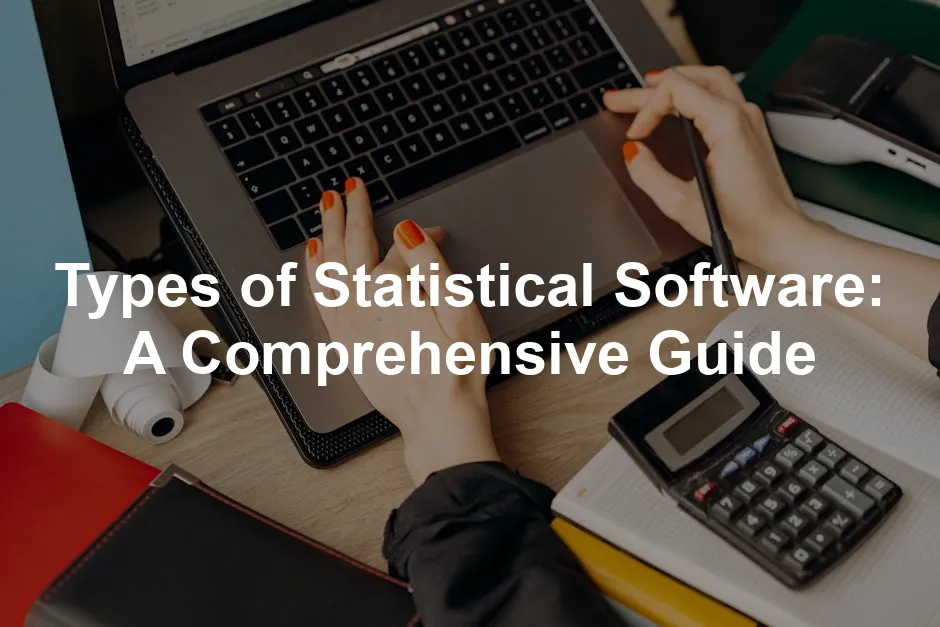Introduction
Statistical software plays a vital role in data analysis. It helps researchers and professionals make sense of complex data across various fields. With the explosion of data in recent years, the demand for effective statistical tools has grown tremendously. Today, a diverse range of statistical software options is available, catering to different needs and preferences.

Summary and Overview
Statistical software refers to specialized applications designed for performing complex data analysis. These tools are essential for organizing, interpreting, and presenting data effectively. Over the years, statistical software has evolved significantly, moving from basic calculators to sophisticated applications capable of handling massive datasets.
Industries like healthcare, finance, and social sciences increasingly rely on statistical software for decision-making and research. In healthcare, for instance, tools help analyze clinical trial data, while finance professionals use them for risk assessment. Statistical software can be categorized into four main types: open-source, freeware, public domain, and proprietary. Each category offers unique features and capabilities, catering to different user needs and budgets.
Understanding these types helps users choose the right software for their specific requirements. With the right tools, data analysis becomes more efficient, accurate, and insightful. If you’re looking to expand your understanding of statistical methods, consider picking up Data Science for Dummies. It’s a great resource for beginners and seasoned data scientists alike!

Public Domain Software
Public domain software is freely available for anyone to use, modify, and distribute. This kind of software often serves specific fields, making it a popular choice for government and public health sectors. Researchers and organizations can access these tools without licensing fees, which encourages widespread usage and collaboration.
Key Examples
Epi Info: Developed by the CDC, Epi Info is a powerful tool for public health professionals. It allows users to design surveys, analyze data, and visualize results. With its focus on epidemiology, Epi Info is ideal for tracking disease outbreaks and evaluating health programs. This software is widely used in public health research, making it an essential resource for health departments and researchers. If you want to enhance your public health research, download Epi Info today!

CSPro: The Census and Survey Processing System (CSPro) is another public domain tool. It plays a vital role in census data processing and management. CSPro helps organizations manage large datasets effectively and supports various data entry and editing tasks. Governments and NGOs frequently use this software for demographic studies and population analysis.
Statistics show that public domain software is increasingly utilized in government and public health sectors. Its accessibility allows researchers to perform essential analyses without incurring costs, promoting transparency and data sharing.
If you’re involved in public health research, consider downloading Epi Info. It’s a valuable resource that can enhance your data analysis capabilities. Also, if you fancy diving deeper into data science, check out R for Data Science. This book is an excellent guide for anyone looking to harness the power of R!
Freeware Statistical Software
Freeware refers to software that is available at no cost but may have some limitations. Unlike open-source software, freeware typically does not allow modifications or redistribution. However, these tools can be quite powerful and serve various analytical needs.

Key Examples
WinBUGS: This software is specifically designed for Bayesian analysis, making it a go-to choice for statisticians. WinBUGS provides a user-friendly interface for complex modeling and is widely used in various fields, including epidemiology and social sciences. Its capabilities make it an essential tool for those working on advanced statistical methods. If Bayesian analysis is your jam, definitely give WinBUGS a try!

GeoDA: This software focuses on spatial data analysis. GeoDA allows researchers to examine geographical patterns and relationships in their data. It’s particularly useful for urban planning, environmental studies, and public health research. Users appreciate GeoDA for its intuitive interface and robust analytical features.
In comparing functionality versus cost, freeware often provides solid capabilities without the financial burden. While some limitations exist, these tools are excellent for researchers seeking effective analytics without a hefty price tag. For those interested in data analysis from scratch, Data Science from Scratch: First Principles with Python is a fantastic read!
Proprietary Statistical Software
Proprietary software refers to commercial programs that require a license for use. These tools are often utilized in academia, healthcare, finance, and various industries for their powerful analytical capabilities. Researchers and organizations invest in proprietary software for its reliability and extensive support.

Key Examples
SPSS: Known as the Statistical Package for the Social Sciences, SPSS is widely popular among social scientists. It’s designed for complex data analysis, providing a user-friendly interface. Researchers appreciate its ability to handle large datasets, perform various statistical tests, and generate comprehensive reports. SPSS is frequently used in health sciences and marketing research. For more information on troubleshooting, check out the macOS IBM SPSS Statistics Fix 28.1.1.

SAS: The Statistical Analysis System is a leader in enterprise data analytics. Organizations use SAS for advanced analytics, business intelligence, and predictive modeling. Its robust features are ideal for handling massive datasets and performing sophisticated analyses. SAS is prevalent in finance, healthcare, and government sectors. A detailed examination of its application can be found in the context of Arkansas crime statistics.
Stata: Stata is a powerful tool for economic research and social sciences. It excels in data management and statistical analysis, offering features tailored for econometrics. Researchers value its capabilities in handling panel data, survey data, and time-series analysis. Stata’s versatility makes it a favorite among economists and public health researchers. If you’re looking to delve into econometrics, grab a copy of The Elements of Statistical Learning. It’s a great resource!

Statistics indicate that proprietary software holds a significant market share in statistical analysis, with user demographics spanning across academia and various industries. SPSS, SAS, and Stata together dominate this space, demonstrating their importance in effective data analysis.
If you’re considering proprietary software, reach out to leading vendors for demos. Exploring these tools can help you find the right fit for your analytical needs. For those interested in a comprehensive guide, the Data Science Handbook is a must-read!
Specialized Statistical Software
Specialized statistical software is crafted for specific fields, addressing unique analytical needs. These tools enhance research capabilities in niche areas, making complex data analysis more accessible.

Key Examples
GraphPad Prism: This software is tailored for biostatistics and is widely used in the healthcare sector. Its intuitive interface simplifies regression analysis and allows researchers to create publication-quality graphs. Users appreciate its focus on statistical tests relevant to biological data. If you’re in the life sciences, you might want to check out GraphPad Prism for your analysis!

MATLAB: A favorite among engineers and mathematicians, MATLAB is designed for mathematical computations and data analysis. It provides extensive toolboxes for statistical modeling, making it invaluable for research and engineering applications. Its programming environment allows for high-level data manipulation and visualization.
EViews: Known for econometric analysis, EViews specializes in time-series data and forecasting. Researchers in economics and finance rely on its powerful tools for modeling complex relationships and conducting rigorous analyses. Its user-friendly interface makes it accessible for both novice and experienced analysts. If you’re looking to deepen your understanding of time-series analysis, grab Introduction to Time Series and Forecasting. It’s a great resource!

Specialized software usage statistics show that these tools are essential in their respective fields, supporting targeted research needs. They provide robust capabilities that generic software may lack, enhancing the accuracy and efficiency of analyses.
For targeted research needs, consider exploring specialized software tailored to your field. These tools can significantly improve your analytical capabilities and outcomes. Additionally, if you’re interested in a comprehensive overview of data science, The Complete Guide to Data Science is a fantastic choice!
Software Comparison and Evaluation
When choosing statistical software, it’s vital to evaluate your options carefully. The right software can make a significant difference in your analysis process. Here are the key criteria to consider when assessing statistical tools.

Usability
Usability refers to how easy the software is to navigate. A clean interface can significantly enhance your experience. Consider the learning curve as well. Some software offers intuitive designs, while others may require extensive training. A user-friendly platform can save you hours of frustration.
Functionality
Functionality encompasses the range of statistical methods available. Different software excels in various areas. For instance, some are great for basic analysis, while others offer advanced techniques like machine learning and simulations. Make sure the software aligns with your specific analytical needs.

Cost
Cost is always an important factor. Some tools are free, while others require paid licenses. Free options can be powerful but may lack certain advanced features. Consider your budget and the value you’re getting. Remember, investing in robust software can pay off in terms of time saved and accuracy gained. For insights into cost behavior, refer to this analysis.
Support
Support can make or break your experience. Check if the software provides tutorials, user forums, or customer service. Having access to a supportive community can be invaluable, especially when you’re facing challenges. A well-documented software with active user support can enhance your learning curve.
User satisfaction ratings provide insight into how well the software performs in real-world applications. Popular platforms like SPSS, R, and Python consistently receive high ratings for usability and functionality. If you want to learn Python for data analysis, the book Python for Data Analysis is highly recommended!

In summary, when comparing statistical software, focus on usability, functionality, cost, and support. Keeping these criteria in mind will help you choose the right tool for your analytical journey.
For a structured approach, consider using our checklist to help you select the best statistical software that meets your needs.
Trends in Statistical Software
The landscape of statistical software is constantly evolving. Staying updated with current trends can help you choose the right tools for your data analysis needs. Here are some trends that are shaping the future of statistical software.
Cloud-Based Solutions
Cloud-based software is becoming increasingly popular. These platforms allow users to access their data from anywhere. This flexibility is essential for teams that work remotely or across various locations. Cloud solutions often offer collaborative features, making it easier for teams to analyze data together.

Integration of AI and Machine Learning
Many statistical tools are now incorporating artificial intelligence and machine learning. These technologies enhance predictive analytics and automate complex processes. This trend not only improves accuracy but also saves time, allowing users to focus on interpreting results rather than getting bogged down in calculations.
User-Friendly Interfaces
User-friendly interfaces are a priority for software developers. As more people engage in data analysis, tools must cater to users with varying skill levels. Simplified navigation and drag-and-drop features make it easier for beginners to start analyzing data. This trend is vital for democratizing data analysis.
Statistics indicate a significant growth in cloud-based software adoption. As businesses increasingly rely on remote solutions, this trend will likely continue. If you’re interested in learning more about data mining concepts and techniques, check out Data Mining: Concepts and Techniques. It’s a great resource!
In conclusion, keeping an eye on these trends—cloud solutions, AI integration, and user-friendly designs—can enhance your statistical analysis capabilities.
Stay informed about the latest developments in statistical software to make the best choices for your projects and analyses.
Future of Statistical Software
As we look ahead, the future of statistical software promises exciting advancements. The field is evolving rapidly to meet the increasing demand for efficient data analysis tools. Here are some predictions we can expect in the coming years.
Increased Automation in Data Analysis
Automation will play a crucial role in statistical software. Expect tools to streamline repetitive tasks, allowing users to focus on interpretation rather than execution. This shift will enhance productivity and accuracy.
Growth of Open-Source Contributions
Open-source software is gaining momentum. More developers will contribute to these platforms, enriching their capabilities. This community-driven approach fosters innovation and provides users with powerful, cost-effective solutions.
Enhanced Real-Time Analysis Capabilities
Real-time data analysis is becoming essential. Future software will likely feature advanced algorithms for processing data on-the-fly. This capability will enable organizations to make timely, data-driven decisions.
Statistics show that the data analytics market is projected to grow from $274 billion in 2022 to $512 billion by 2026. This exponential growth indicates a strong demand for more sophisticated analytical tools. If you want to delve deeper into statistical learning, consider picking up The Signal and the Noise: Why So Many Predictions Fail – but Some Don’t. It’s an insightful read!
What are your thoughts on the future of statistical tools? Share your insights in the comments below!
Conclusion
Choosing the right statistical software is vital for effective data analysis. With so many options available, from open-source to proprietary solutions, it’s essential to consider your specific needs. Each software type has its strengths and weaknesses, catering to various industries and applications. By understanding these options, you can make informed decisions that enhance your data analysis capabilities. Take time to evaluate your requirements, and select the software that aligns best with your goals.
Please let us know what you think about our content by leaving a comment down below!
Thank you for reading till here 🙂
All images from Pexels




